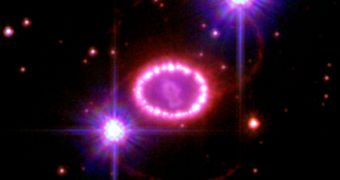A comparison between supernova explosions taking place today and those that occurred early in the life of the universe reveals that the latter appear to age slower, as if time was warped somehow. It may look as counterintuitive or even impossible to some of us, but in fact, this is confirmed by the inflation theory, stating that soon after the Big Bang the universe suffered a sudden expansion into space-time and is still expanding even today.
The expansion of the universe had been predicted through Einstein's General Theory of Relativity and later confirmed through a series of tests, amongst which the studies conducted by Edwin Hubble on the galaxies in the vicinity of the Milky Way. The expansion of the universe is also responsible for the 'redshift' of the light coming from cosmic bodies in the distant universe. As light travels through space and the matter of the universe expands, the wavelengths of the universe are stretched towards the red end of the electromagnetic spectrum.
This effect is in fact occurring all over the universe, regardless of its size, albeit it may remain undetectable on the small scale. Therefore, if a series of light flashes were generated in the distant universe, to us they would appear to arrive farther and farther apart and shifted towards the red end of the light spectrum. The same applies to the light coming from type Ia supernova explosions.
Time dilatation
Type Ia supernovae are determined by the thermonuclear explosion of white dwarf stars, most of which are present in the near vicinity of our galaxy. "Type Ia supernovae are just so predictable", says Notre Dame University researcher, Peter Garnavich. Because the spectrum of light emitted by such supernovae is well known, any changes in the wavelengths are immediately detected.
"At first, only the outer layers of the supernova are visible. As time passes by, the outer layers thin out, and we are able to see deeper and deeper layers of the supernova ejecta", Harvard University researcher and lead author of the study, Stephane Blondin.
As lower layers of the white dwarf become visible, they start emitting light characteristic to the chemical elements. "These changes in chemical composition as deeper layers become visible leave an imprint on the resulting spectrum", explains Blondin.
Two previous studies had already established that the time dilatation phenomenon is real. The new calculations show that supernova explosions in the early universe age by up to 60 percent slower than those seen today, and are directly linked to the redshift of light, thus space-time expansion is the most probable cause for the seen effects. "Any deviation from the predicted time-dilation factor would have profound implications for cosmology", concluded Blondin.

 14 DAY TRIAL //
14 DAY TRIAL //